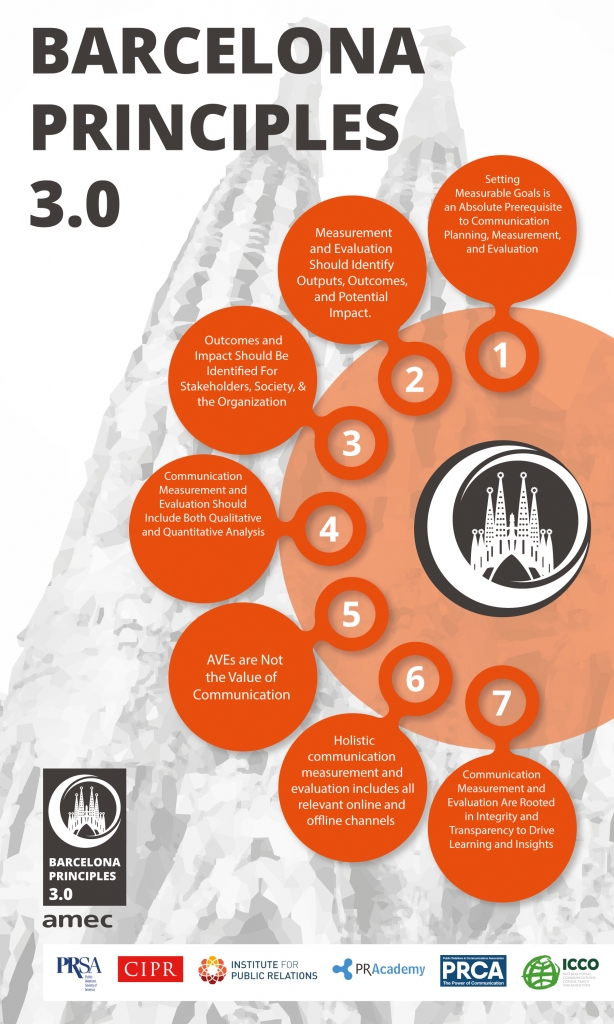Written by Aditi Soni
Public Relations (PR) students learn everything from writing content to managing a crisis, but one crucial aspect often overlooked in education is the Barcelona Principles. These principles lay the groundwork for measuring the efficiency of PR campaigns. In this blog, we will delve into the current set of guidelines, ‘Barcelona Principles 3.0’, and touch upon its predecessors to give PR newcomers a comprehensive understanding.
Answering the important questions first:
1. What are Barcelona Principles? – The Barcelona Principles refer to the Barcelona Declaration of Research Principles, a set of seven voluntary guidelines established by the PR industry to measure the efficiency of PR campaigns. They were the first overarching framework for effective public relations and communications
measurement. These principles serve as a guide for practitioners to incorporate the ever-expanding media landscape into a transparent, reliable, and consistent framework.
2. Who decided these principles? – The Barcelona Principles were agreed upon by PR practitioners from 33 countries who met in Barcelona, Spain in 2010 for a summit convened by the International Association for Measurement and Evaluation of Communication (AMEC). Following an international consultation and involving AMEC Regional Chapters, the new-look Barcelona Principles 3.0 were unveiled in July 2020.
About Barcelona Principles 3.0:
1. Setting goals is an absolute prerequisite to communications planning, measurement, and evaluation.
Goals are essential to achieving PR campaign efficiency. These goals should follow the SMART concept (Specific, Measurable, Achievable, Relevant, Time-bound) and be revisited throughout the campaign/year. All results should be evaluated against these pre-defined goals.
2. Measurement and evaluation should identify outputs, outcomes, and potential impact.
Previously, the Principles recommended measuring outcomes, rather than simply counting outputs. The updated principles extend this to consider longer term impact of communications strategy. Also, consider solid data points when defining the goals, that would include identification of tools and tracking methods, KPIs, and
benchmarks.
3. Outcomes and impact should be identified for stakeholders, society, and the organization.
Moving from a focus on business metrics like sales and revenue, the 2020 update embraces a holistic view of performance, inclusive of various organizations and roles, even those not profit-driven. For example, a nonprofit organization might measure success by the increased volunteer engagement or improved public sentiment rather than financial gain. This broader perspective ensures that PR efforts are aligned with the diverse objectives of different stakeholders and societal impacts.
4. Communication measurement and evaluation should include both qualitative and quantitative analysis.
Effective measurement assesses how communication reached and engaged target audiences and what messages were communicated. Quantitative measures include impressions, reach, share of voice, engagement, and surveys. Qualitative measures encompass emotional response, call-to-action, endorsements, and interviews.
For example, while quantitative data might show that a campaign reached a million people, qualitative data might reveal that the campaign effectively changed public perception or motivated action among the audience.
5. AVEs are not the value of communication.
Barcelona Principles 3.0 still stand true to this principle documented in 2010. Advertising Value Equivalents (AVEs) is a flawed metric that calculates the eventual cost of the size of the coverage gained. The alternative given is to calculate the cost of space or time from earned versus paid media.
6. Holistic communication measurement and evaluation includes all relevant online and offline channels.
The principles evolve with the changing communication landscape, particularly the rise of social media. The 2020 iteration emphasizes measuring across earned, owned, shared, and paid channels to ensure a consistent approach towards a common goal. This comprehensive approach ensures that all forms of communication, from traditional media to digital platforms, are considered. For instance, a campaign might be evaluated based on its performance across press releases, blog posts, social media engagement, and paid advertisements, providing a complete picture of its effectiveness. They urge the PR practitioners to go beyond “coverage”; or vanity metrics such as “likes”; and “impressions”; to have a better understanding of the target audience ecosystem by focusing measurement on engagement, conversion, perception/attitude change, consideration, and purchase intent/behaviour change.
7. Communication measurement and evaluation are rooted in integrity and transparency to drive learning and insights.
Consistent and sustained measurement requires integrity and transparency, respecting data privacy and regulations like GDPR. This principle underscores the importance of ethical practices in data collection and analysis, ensuring that the insights gained are reliable and actionable. For example, PR practitioners should be transparent about their methodologies and honest about the limitations of their data, fostering trust and credibility with stakeholders.
The Barcelona Principles 3.0 are endorsed by major organizations such as the Institute of Public Relations, the Public Relations Society of America, the Public Relations and Communications Association, and others within the PR industry. However, these principles are voluntary, and PR professionals can decide whether or not to adhere to them. The extent to which individuals incorporate these guidelines into their work is entirely at their discretion.
For those interested in learning more about the principles, further information is available here.
Have you implemented the Barcelona Principles in your PR practice? Share your experiences and insights with us!

